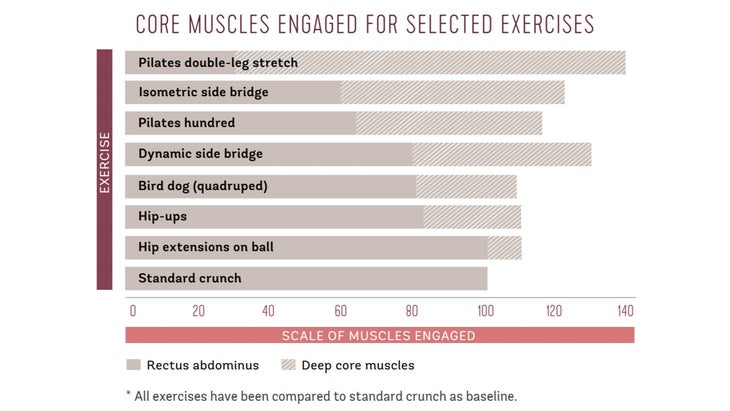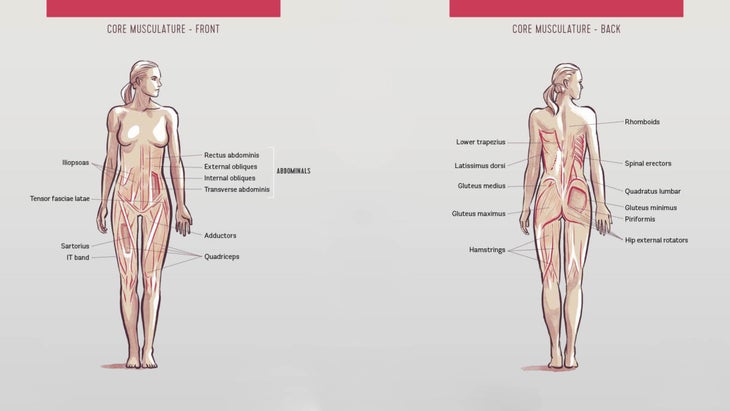New perk! Get after it with local recommendations just for you. Discover nearby events, routes out your door, and hidden gems when you sign up for the Local Running Drop.
Crunches don’t utilize a significant percentage of your core musculature. While it feels like you’re working hard when you’re 70 reps into a grueling round of 100 crunches, you are predominantly working a single muscle group—the rectus abdominis (rectus). In actuality, the true “core” of the body includes countless other muscles.
This brings up the issue of function versus vanity. Why wouldn’t you want to focus your gym time on developing a rockin’ rectus? Aren’t those the beach muscles that look great with a spray tan? If a well-developed rectus is what turns heads, do we really need a well-rounded core routine that works all the other muscles? The short answer is that a high-functioning core leads to a better-looking core. Focusing on only a few core muscles can lead to poor posture (which makes your tummy stick out) and injuries (which will inhibit you from being able to work out). Build a solid foundation for your core with a well-rounded core routine, and you will accomplish the dual goals of looking good while being strong and pain-free.
RELATED: Yes, Building a Strong Core Really Can Help Nix Back Pain
When I talk about the foundation for your core, I’m not referring just to the intricate musculature beneath your abs. Your glutes and hamstrings are also involved. These muscles are traditionally categorized as “lower-body” muscles, but they serve a dual function in helping to stabilize and move the pelvis, which makes them part of the core. In fact, any muscle that is attached to either the pelvis or the spine is technically part of the core. Add to the major muscle groups all of the smaller, deeper muscles in this area, and the count of how many muscles are in the human core easily reaches into the hundreds. If your core strengthening routine is based solely on crunches, you’re neglecting 95 percent of your core musculature.
RELATED: The Basics of Building a Strong Core for Running
When a large percentage of your core muscles is routinely ignored, it creates a scenario called muscular imbalance in which a muscle or group of muscles becomes tight and overactive, therefore causing a neighboring or opposing muscle to become weak and underactive. The imbalance is problematic because our muscles control our joints and bones, and when a certain muscle is doing too much work, it will start to pull the bones and joints it is attached to into uncomfortable positions.
For example, when our friend the rectus abdominis becomes overactive, it pulls the rib cage and pelvis closer together. Repetitively bringing your rectus muscles into a contracted, or shortened, position results in poor posture and can ultimately place excessive pressure on the discs of the spine, causing pain and even long-term injury.

Most people have core musculature that is extremely imbalanced, primarily because we already do exercises that work on strengthening only the rectus. Such exercises are particularly problematic because we are already shortening our rectus all day while we sit in the car, sit at our desks, sit on the couch, or slouch while we walk. Simply stated, we don’t need to work our rectus because is it already over-worked and overactive.
RELATED: 5 of the Best Isometric Core Moves for Runners
Instead of doing exercises that shorten the rectus, we need to focus on exercises that recruit the deep core muscles. Scientific studies have actually proven that crunches and similar movements that involve trunk flexion do not activate the core muscles as effectively as do other exercises. In a recent study conducted at Auburn University, researchers tested the efficiency of popular core exercises through the use of electromyography. By positioning electrodes on the skin over the muscles that are being tested, this technology measures the level of contraction found in those muscles.
In order to establish a reference scale for the study, the standard crunch was assigned a value of 100. The exercises with values higher than 100 points showed greater muscular contraction than the standard crunch, and those under 100 had less. The results of the study clearly show why crunches are out, whereas moves such as the Pilates hundred and the isometric side bridge are in. The exercises that successfully recruit the deep abdominal muscles have two things in common: They require a high degree of stabilization, and they avoid trunk flexion. Additional movements that follow these guidelines include exercises such as the plank hold, the seated boat row, and windshield wipers.
Ab Exercises vs. Core Exercises
The terms “abs” and “core” are not synonymous, though they are often erroneously used interchangeably. The abdominal muscles consist of only four groups of muscles—the rectus abdominis, external obliques, internal obliques, and transverse abdominis—whereas the entire core consists of all the muscles (muscle groups) depicted in the figures below. You might have strong abs, but this does not mean your entire core is strong!
Ab Exercises: Reverse crunch, side crunch, traditional crunch, bicycle crunch.
Core Exercises: Plank holds, squats, mountain climbers, bird dogs.

In addition to recruiting the deep core muscles, we need to recruit the big movers of the core, primarily the gluteals. You can’t have an enviable core without having glutes that are strong and functional. I’ve had many a client make the argument that her butt is already big, so it must be strong. Well, we’ve all heard the adage, but in this case it’s true: Size doesn’t matter. It’s entirely possible (and very common) to have glutes that take up a lot of real estate but aren’t actually working.
RELATED: The Real Reasons Your Glutes are So Weak
If you want to find out whether or not your glutes are showing up for the job, try the test below. When the glutes are shut off and not firing correctly, the body will rely on other muscles to step in and do the job. Often the muscles that take over for the glutes are smaller (for example, the muscles of the low back) and less efficient. Over time, these muscles will become excessively taxed and will end up causing pain and injury.
Are Your Glutes Firing?
To test the firing capability of your glutes, perform this simple exercise. Lie on your back with your knees bent and your feet on the ground 8 to 10 inches from your glutes. Lift one leg off the floor. Pressing through the opposite heel, lift your hips as high off the ground as possible. You should feel this movement primarily in the glute of the leg pressing into the floor. Complete 15 repetitions, then switch to the other leg.
If you feel the movement in your glutes, then your posterior is functioning properly. If you feel it in your hamstrings and low back, then you need to focus on glute activation and strengthening exercises.
RELATED: Work Your Glutes with this Quick Single-Leg Exercise
Adapted from Core Envy: A 3-Step Guide to a Strong, Sexy Core by Allison Westfahl with permission of VeloPress.